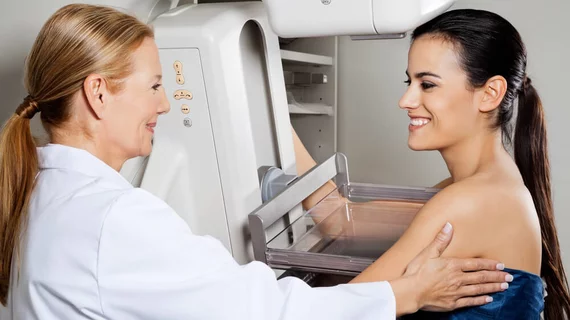What would risk-based breast cancer screening mean for women in their 40s?
Is risk-based mammography screening a more effective strategy for women 40 to 49 years old than age-based screening? A new study published in Radiology aimed to explore that very issue.
“Virtually all mammography screening trials use an age-based rather than a risk-based recruitment strategy, emphasizing the importance of studying the effectiveness of risk-based breast cancer screening strategies prior to implementation,” wrote Elizabeth S. Burnside, MD, department of radiology at the University of Wisconsin-Madison School of Medicine and Public Health, and colleagues. “Growing interest in risk-based screening creates an urgent mandate to determine effectiveness.”
The authors examined data from more than 10,000 consecutive digital screening mammograms from the same institution. The examinations occurred between Jan. 1, 2006, and Dec. 31, 2013, and all patients were between the ages of 40 and 49 and at an average risk of breast cancer. Using the data of those previously interpreted mammograms, Burnside et al. compared two hypothetical screening scenarios—an age-based screening for women 45 years old or older and a risk-based scenario that examined the patient’s five-year risk.
Overall, “usual care” for women ages 40 to 49 resulted in 50 screening-detected cancers, more than 1,700 false-positive mammograms and 384 benign biopsies. Age-based screening for women 45 years old or older resulted in 34 screening-detected cancers, 899 false-positive mammograms and 175 benign biopsies. Risk-based screening, meanwhile, resulted in fewer screening-detected cancers (13), false-positive mammograms (216) and benign biopsies (49).
In addition, the researchers observed risk-based screening led to few women ages 40 to 44 being screened.
“Significant differences between hypothetical screening scenarios in terms of cancers detected, false-positive mammograms, and benign biopsy results were driven by outcome divergence in the 45–49-year age range because screening is comparably low in the 40–44-year age range,” the authors wrote.
Burnside and colleagues noted that some of the differences between age- and risk-based screening could be viewed as a negative—the drop in screening-detected cancers, for instance—but that there were also key benefits of risk-based screening.
“When choosing a screening strategy, physicians, patients, and policymakers will need to determine whether the trade-offs in both short-term and long-term outcomes are acceptable, while also weighing the practicality and complexity of each strategy,” the team concluded.

